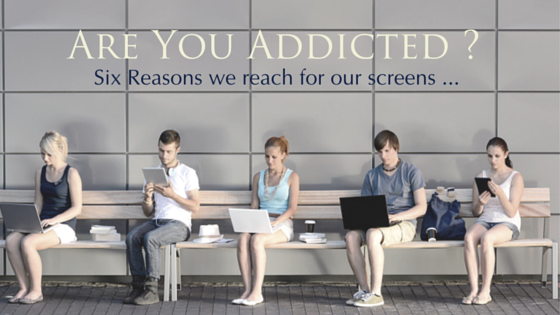Having just written a post last week about going more digital and “paper-less,” I feel the need to follow with an exploration of our modern relationship with our screens. I live fully in the 21st century’s digital lifestyle, which can mean that I have a screen (computer, phone, TV, tablet) turned on for LARGE sections of my day, I would even say virtually all day.
In fact, I’m falling more deeply in love with my yoga studio simply because it’s a guaranteed hour ever day away from any screens (other than checking in for class for 30 seconds.) But, that brings me to the key point. These are powerful devices that have improved our lives in many ways, but like many of you I am frequently questioning “When is it a tool and when is it a toy?”
According to a recent study published by Deloitte, the average American (across all age brackets) checks their smartphone 46 times per day. (I bet it goes up dramatically in younger age brackets.) We can do just about anything with our devices these days… that’s why we all joke “There’s an app for that.” And, as the video on Vintage News showed, most of our standard desk tools are now handled by apps. The good news is that our lives have the ability to be SO MUCH more flexible and mobile than ever before, as I explored in my last post.
However, it also becomes all-consuming… We never need to look away from the screen because it has everything we need. All the answers are there, or it feels that way at times. This challenge was both clarified and thrown into relief for my family when we started declaring “Screen-Free days” every few weeks. I wrote about creating Tech-Free time in Inspired Action and offered recommendations for questions and strategies that you can use to carve out more of this time in your life.
Since writing that chapter, I’ve been watching how our “Screen-Free days” have evolved. They started as a blanket “no screens on at all.” Now, the new guideline is to only use screens if they are a tool to help us accomplish something non-screen related. (i.e. GPS to drive to the arboretum, camera to take a few photos to remember the experience, recipes to cook our food.)
As Brian & I reflected on the role of screens in our lives we recognized a pattern that we thought might be useful to share with you when reflecting on your own screen-time… So, let’s talk about the Six Reasons We Reach for Screens.
1. Connection
With social media, Facebook, etc. many of our relationships are being conducted virtually. I find out more news about my distant friends (or even local friends) via Facebook than anywhere else. Who’s sick, who’s getting married, who’s taking a trip to Ireland, who just lost a loved one… all this information is being shared via Facebook now.
Whether you approve of this shift in our relationships or not… it’s a lot easier to get these snapshots of people’s lives or to update hundreds of people at once on your big news via these means rather than hundreds of phone calls or meetings over coffee.
2. Fear of Missing Out/ Anxiety
Similarly, as we’ve become programed to look at our screens to find out what’s happening (either with those we love or in the wider world), we’ve developed a secondary reflex of checking our devices because we’re afraid of missing out on something important. Whether that’s the email from your client, or the text message from your new honey, or the latest stock price for a specific company, we’ve become almost compelled to check.
It’s getting to the point where researchers have even started studying nomophobia as an anxiety disorder triggered by being without our mobile phone. Have you ever had that feeling? Suddenly, you realize that you left your phone at home or at work, and you feel your heart clench and your blood race? It’s real, folks… and there are even people studying it.
3. Entertainment or Education
We need never be bored again, after all there’s always a few more cute cat videos to watch. Our screens have become the insta-cure for boredom. We have access to more videos, blogs, and social media posts than we could ever in thousands of lifetimes consume. So, our screens ensure that we remain constantly entertained, inspired, and educated about our world.
The downside being that we are conditioned to consume rather than create… why think hard to create something new when we could just watch another video of small dogs missing the jump and face planting into a couch. Hmmm, so tempting, and yet, a concern.
4. Reference
As more of our information is stored digitally, often we’re opening up our device simply to access information we want. Someone’s address, a recipe, a map, looking up how to spell something… this information is now being stored digitally for many people. Or, what about finding the name of an actor in IMDB, or the name of the song playing in a cafe via Soundhound, or ending a debate between friends over what years Prohibition were active… all these answers can be found easily on our devices. Without question, this easy of access to information has improved our lives… it’s also increased our dependence on our devices.
I was actually annoyed with Brian a few weeks ago when I was trying to remember the magic words from the movie Bedknobs and Broomsticks while I was driving, and he refused to look it up for me. (*sigh* 5 minutes of brain-wracking later, and they surfaced “Treguna Mekoides and Trecorum Satis Dee.” Whereas I just found them with a search today in less than 5 seconds.) Ah, how addicted to instant-gratification I’ve become… although I was proud of myself for digging them out of my brain eventually.
5. Work
A lot of my time on devices is spent simply getting things done… writing this blog post being one example. Many of us spend the bulk of our day working on computers, and when we’re away from the computer then our smart phones allow us to still tick off the little tasks. Replying to quick emails, sending a text to a client or co-worker, reviewing our task lists, all of these activities allow us to use our devices to work from almost anywhere… at least anywhere with cell/data service or wifi. I even recently realized that I could tether my laptop to my phone and work from my car while overlooking the ocean in Rockport, MA. Not a bad view for plugging away at an hour of work!
Our devices help us get things done from almost anywhere, which is both good and bad. That also means that you could be working while at dinner with your friends, sitting at your kid’s basketball game, or during date night… perhaps not so great.
6. Habit
With all these completely logical reasons why we might be reaching for our devices, I think the #1 reason that most of us grab for a screen is HABIT. It’s just become “the thing we do.”
Whenever we have a moment of downtime we reach for a screen. Once we have it in our hands we might use it to satisfy a specific desire or need, but the reality is that that satisfaction fuels our addiction. Turning on our device carries with it an intrinsic reward for most of us, and that’s why we spend all day looking at them. It gives us a hit of whatever we feel we need in that moment and becomes a self-reinforcing habit.
Breaking the Cycle
The bottom line is that while I LOVE my devices and have no intention of going without them in the future. I also want to break my addiction and perhaps you do too. I believe that road starts with awareness and intention.
What would happen if before you turned on your phone, computer, TV, etc. you paused and asked “What’s my intention right now? Does turning on this device serve and support that intention or distract me from it?”
I believe that one of the greatest challenges we’re facing in the next few decades of the 21st century is re-programming our minds to consistently act intentionally, with focus and decision, rather than constantly reacting to whatever dings, flashes, or distracts us. With SO many options always within reach, we are facing the need to build our ability to intentionally choose where our attention goes. Our screens give us a chance to practice that decision-making almost every minute.
Now that you’re done reading this… where will you choose to put your attention next?



